Susannah Maidment* describes a new stegosaur from Montana whose distribution sheds new light on dinosaur ecology.
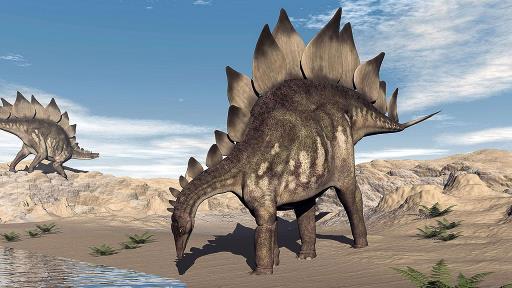 If you were to ask a room full of seven-year-olds what a Stegosaurus looked like, they’d have no problem describing to you the armoured dinosaur with a double row of plates and spines extending from its neck to the end of its tail. Stegosaurs are some of the most easily-recognisable dinosaurs.
If you were to ask a room full of seven-year-olds what a Stegosaurus looked like, they’d have no problem describing to you the armoured dinosaur with a double row of plates and spines extending from its neck to the end of its tail. Stegosaurs are some of the most easily-recognisable dinosaurs.
Picture: Reconstruction of Stegosaurus, dinosaur ‘icon’.
But their iconic status belies their rarity as fossils: stegosaurs are some of the least well-known of the bird-hipped (ornithischian) dinosaurs. Their fossils tend to be fragmentary – indeed, most genera are represented by only a single specimen! Consequently, much remains unknown about their palaeobiology and lifestyles.
Morrison Formation
Stegosaurus, from the USA, is the best-known member of the group, which also includes genera from the UK and across Europe, China, and Tanzania. Stegosaurus is known from the Morrison Formation, a swathe of Upper Jurassic fluvial and overbank strata that crop out all the way from Montana in the north to New Mexico in the south.
Remains of dinosaurs from the Morrison were first discovered in Colorado and Wyoming in the latter part of the 19th Century, and the Formation has been intensively studied ever since. Stegosaurus fossils from the Morrison are now known from Utah, Colorado, and southern Wyoming; but none had ever been found in the thinner, and more poorly-known, Morrison sediments of Montana, the so-called ‘Treasure State’.
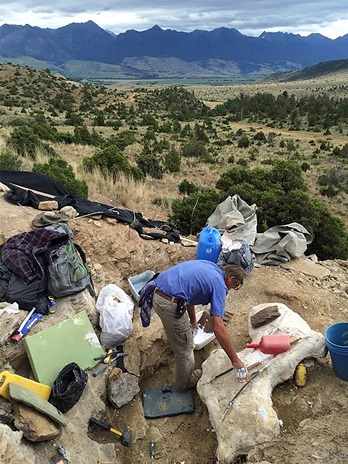 Discovery
Discovery
In the summer of 2015, a field crew from the Museum of the Rockies was excavating in a dinosaur quarry near Livingston, Montana. The site had previously produced remains of the meat-eating dinosaur Allosaurus and of the giant sauropod Camarasaurus. Montana State University (MSU) undergraduate Jack Wilson was working in the quarry that summer; and as he scraped off the soft grey mudstone from a layer of orange, fine-grained sandstone, something flat, black and shiny caught his eye.
Picture: MOR chief preparator Bob Harmon readies the field jacket containing the Livingston stegosaur for return to the Museum.
He called over Cary Woodruff, an MSU Masters student, who was running the dig. Cary says: “I saw the surface texture and I immediately knew what it was: a plate from a Stegosaurus”. Over the following days and weeks, the dig crew found limb bones and vertebrae close to the plate, which they excavated, jacketed (picture), and returned to the Museum of the Rockies for preparation.
Intact skull
It was not until sometime afterwards, back in the prep lab, while gently removing sediments from around the bones, did the Museum preparators find that most rare and prized of all elements - a complete and intact skull. Cary knew that very few complete stegosaur skulls were known from anywhere in the world. He also knew that no stegosaurs of any kind had been described from Montana. Suspecting that the specimen might be something new and interesting, he got in contact with me, and asked me to visit the Museum of the Rockies to work on it. The Geological Society kindly provided a grant to help me do this*.
I was excited when I first saw the specimen. The skull was extremely well preserved. Although it was fractured into five blocks, this fragmentation allowed me to build up a very clear picture of the internal structure of the skull bones and braincase. The palate is the best preserved of any stegosaur from anywhere in the world - shedding light on the anatomy of the fragile bones connecting the roof of the mouth and braincase. And, based on the structure of the vertebrae, I was immediately able to identify the specimen as Stegosaurus mjosi - an extremely rare species known only from four specimens - all from the State of Wyoming.
Small
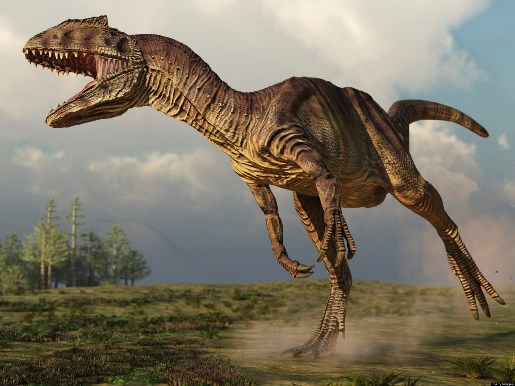 Something that immediately struck me when I first saw this new specimen was how small it was. I suspected that it might not have been fully grown at time of death – so, to investigate that, we cut thin sections of the leg bones.
Something that immediately struck me when I first saw this new specimen was how small it was. I suspected that it might not have been fully grown at time of death – so, to investigate that, we cut thin sections of the leg bones.
Picture: Reconstruction of the carnivorous dinosaur Allosaurus.
The texture of bone tissue can provide an indication of growth stage of an animal. Bone that was deposited rapidly, while the animal was growing quickly in youth, contains many spaces for blood vessels. If, on the other hand, it was deposited slowly - after growth had slowed significantly in adulthood - the bone texture would be denser. Sure enough, when we looked at the leg-bone tissue under the microscope, we found that the individual’s growth had not yet slowed at time of death. It was probably a ‘sub-adult’.
We compared the size of the new specimen to other specimens of Stegosaurus that had been examined for ontogenetic stage in the same way. We found that our specimen was still smaller than specimens of the better-known species Stegosaurus stenops, that had been about the same age when they died.
Distribution
The occurrence of the new specimen, representing a rare species, far up in the north of the Morrison depositional basin, prompted me to investigate the distribution of Stegosaurus within the formation. I went to the Paleobiology Database (PBDB; www.paleobiodb.org) - an online resource that aims to record every published fossil occurrence.
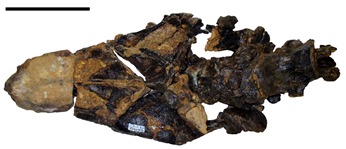 Fortunately, the database is relatively complete for dinosaurs, and occurrence and location data can be directly downloaded for visualization in a GIS package. Of 40 Stegosaurus specimens in the PBDB, 36 are referable to S. stenops, and only four to S. mjosi. Intriguingly, S. stenops is found predominantly in Utah, Colorado, and southern Wyoming, while S. mjosi is known only from Wyoming and Montana.
Fortunately, the database is relatively complete for dinosaurs, and occurrence and location data can be directly downloaded for visualization in a GIS package. Of 40 Stegosaurus specimens in the PBDB, 36 are referable to S. stenops, and only four to S. mjosi. Intriguingly, S. stenops is found predominantly in Utah, Colorado, and southern Wyoming, while S. mjosi is known only from Wyoming and Montana.
Picture: The skull, in ventral view, looking at the palate. The front of the skull is to the left and the first few vertebrae are attached on the right. The scale bar is equal to 10cm.
The fossil record, however, does not faithfully chronicle the distribution patterns of past life. It is beset by many biases that skew the data. The absence of S. stenops from Montana could be a sampling bias: many more excavations have been carried out in the better-exposed Morrison of Utah and Colorado than in the tree-covered rolling hills of Montana.
However, after about 150 years of excavation in the Morrison of Utah and Colorado, not a single individual of S. mjosi has been found. Based on available data, therefore, it appears that these two species of Stegosaurus were latitudinally segregated in the Morrison depositional basin. S. mjosi seems to have occupied the wetter, cooler, northern parts of the basin, while S. stenops occupied the arid south. We really need more discoveries of complete or nearly complete skeletons in Montana and Wyoming to test this hypothesis, however.
Size and climate
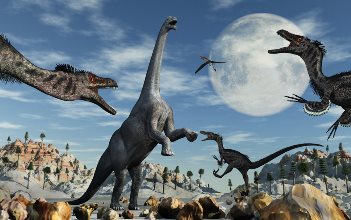 Among living herbivore species, large size has been considered as an adaptation to arid climates. This is because physiological life-processes scale with body mass to the 0.75 – or, in other words, larger animals can get by on less nutritious food than their smaller relatives can. Large animals also have a longer stride, meaning that they can reach more disparate food sources using less energy.
Among living herbivore species, large size has been considered as an adaptation to arid climates. This is because physiological life-processes scale with body mass to the 0.75 – or, in other words, larger animals can get by on less nutritious food than their smaller relatives can. Large animals also have a longer stride, meaning that they can reach more disparate food sources using less energy.
Picture: Reconstruction by Mark A Stevenson of the herbivore Camarasaurus, discovered in the Morrison Formation by Oramel Lucas in 1877 and named by E Drinker Cope.
One of the most intriguing observations of our work on the Livingston stegosaur is that it suggests that S. mjosi was a smaller species than S. stenops. Perhaps the large size of S. stenops was an adaptation to the arid climates of the south Morrison basin.
The documentation of new fossil finds like this is important. Each new discovery helps to shed new light on the lifestyles of the animals in question, which in turn can help us examine the ecosystems in which they lived, and so allows us to understand some of the most pressing ecological questions of our own time - such as how ranges of large terrestrial vertebrates will change in response to changing climatic conditions.
 *Susannah Maidment, who received the Lyell Fund of the Geological Society on President’s Day last month, is Senior Lecturer in Geology at the University of Brighton. At the time of this research, she was a Junior Research Fellow at Imperial College. Her research was supported by the Society’s Edmund Johnson Garwood Fund. For more information on applying for a Society Research Grant in 2018, go to W: www.geolsoc.org.uk/grants.
*Susannah Maidment, who received the Lyell Fund of the Geological Society on President’s Day last month, is Senior Lecturer in Geology at the University of Brighton. At the time of this research, she was a Junior Research Fellow at Imperial College. Her research was supported by the Society’s Edmund Johnson Garwood Fund. For more information on applying for a Society Research Grant in 2018, go to W: www.geolsoc.org.uk/grants.